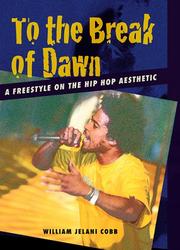| Listing 1 - 10 of 48 | << page >> |
Sort by
|
Book
ISBN: 3830995865 3830945868 Year: 2022 Publisher: Münster : Waxmann,
Abstract | Keywords | Export | Availability | Bookmark
 Loading...
Loading...Choose an application
- Reference Manager
- EndNote
- RefWorks (Direct export to RefWorks)
Zu Beginn der 1980er Jahre entsteht innerhalb der Hip-Hop-Kultur in den USA das Beatmaking - eine Musikpraxis, die auf dem kreativen Umgang mit bereits vorhandenem Klangmaterial basiert und hauptsächlich in informellen Kontexten ausgeübt wird. In den letzten 40 Jahren hat sich das Beatmaking in enger Verbindung mit musik- und medientechnologischen Entwicklungen global verbreitet und vielfältig ausdifferenziert. Dabei hat es vor allem im Bereich der populären Musik in musikalisch-ästhetischer und technisch-praktischer Hinsicht maßgebende Impulse gesetzt.In seiner qualitativ-empirischen Studie geht Chris Kattenbeck der Frage nach, was es bedeutet, als Beatmaker*in künstlerisch kompetent zu handeln, welche Fertigkeiten und Kenntnisse dafür nötig sind und wie diese erworben und entwickelt werden. Damit liefert er grundlegende Erkenntnisse über eine bislang kaum erforschte Musikpraxis und die mit ihr verbundenen künstlerischen Strategien und Techniken, ästhetischen Ziele und Vorstellungen, Wissensformen und Lernpraktiken. Dabei zeigt sich unter anderem, dass bestimmte in der Musikpädagogik vorherrschende Verständnisse - etwa von Musiklernen oder Musiktheorie - ungeeignet sind, das Beatmaking adäquat zu erfassen. Die Studie bietet daher nicht zuletzt Anlass, diese Verständnisse zu hinterfragen und neu zu konzeptualisieren, um mit der Vielfalt musikalischer Praxen in Zukunft angemessen umgehen zu können.
Hip Hop. --- Hip-hop culture --- Hiphop --- African American arts --- Popular culture --- Hip-hop.

ISBN: 0814790046 9780814790045 9780814716700 0814716709 0814716717 9780814716717 Year: 2007 Publisher: New York New York University Press
Abstract | Keywords | Export | Availability | Bookmark
 Loading...
Loading...Choose an application
- Reference Manager
- EndNote
- RefWorks (Direct export to RefWorks)
2007 Arts Club of Washington’s National Award for Arts Writing - Finalist SEE ALSO: Pimps Up, Ho’s Down: Hip Hop’s Hold on Young Black Women by T. Denean Sharpley-Whiting. With roots that stretch from West Africa through the black pulpit, hip-hop emerged in the streets of the South Bronx in the 1970's and has spread to the farthest corners of the earth. To the Break of Dawn uniquely examines this freestyle verbal artistry on its own terms. A kid from Queens who spent his youth at the epicenter of this new art form, music critic William Jelani Cobb takes readers inside the beats, the lyrics, and the flow of hip-hop, separating mere corporate rappers from the creative MCs that forged the art in the crucible of the street jam. The four pillars of hip hop—break dancing, graffiti art, deejaying, and rapping—find their origins in traditions as diverse as the Afro-Brazilian martial art Capoeira and Caribbean immigrants’ turnstile artistry. Tracing hip-hop’s relationship to ancestral forms of expression, Cobb explores the cultural and literary elements that are at its core. From KRS-One and Notorious B.I.G. to Tupac Shakur and Lauryn Hill, he profiles MCs who were pivotal to the rise of the genre, verbal artists whose lineage runs back to the black preacher and the bluesman. Unlike books that focus on hip-hop as a social movement or a commercial phenomenon, To the Break of Dawn tracks the music's aesthetic, stylistic, and thematic evolution from its inception to today's distinctly regional sub-divisions and styles. Written with an insider's ear, the book illuminates hip-hop's innovations in a freestyle form that speaks to both aficionados and newcomers to the art.
Hip-hop. --- Hip-hop culture --- Hiphop --- African American arts --- Popular culture --- Bronx. --- Eminem. --- South. --- artistic. --- evolution. --- from. --- hip-hop.
Book
ISBN: 3959351836 9783959351836 9783959351829 Year: 2015 Publisher: Hamburg
Abstract | Keywords | Export | Availability | Bookmark
 Loading...
Loading...Choose an application
- Reference Manager
- EndNote
- RefWorks (Direct export to RefWorks)
English language --- Hip-hop. --- Hip-hop culture --- Hiphop --- African American arts --- Popular culture --- Influence on German. --- German language --- Germanic languages
Book
ISBN: 1281987034 9786611987039 0199715319 9780199715312 9780195334050 0195334051 9780195334067 019533406X 9781281987037 6611987037 019772793X Year: 2009 Publisher: Oxford New York Oxford University Press
Abstract | Keywords | Export | Availability | Bookmark
 Loading...
Loading...Choose an application
- Reference Manager
- EndNote
- RefWorks (Direct export to RefWorks)
1. Introduction. 2. Getting Your Foundation: Pedagogy. 3. B-Boy Text: Aesthetics. 4. Crews. 5. I hate b-boys - that's why I break: Battling. 6. Like old folk songs handed down from generation to generation: history, canon, and community in B-boy culture. 7. If Breaking came out of Uprock, then Hip-Hop didn't start in the Bronx: B-boy History. 8. Conclusion
Hip-hop dance. --- Hip-hop dance --- Hip-hop --- Music, Dance, Drama & Film --- Dance --- Hip-hop culture --- Hiphop --- African American arts --- Popular culture --- Break dancing
Book
ISBN: 1438469470 9781438469478 9781438469454 1438469454 9781438469461 1438469462 Year: 2018 Publisher: Albany
Abstract | Keywords | Export | Availability | Bookmark
 Loading...
Loading...Choose an application
- Reference Manager
- EndNote
- RefWorks (Direct export to RefWorks)
Expressive culture has always been an important part of the social, political, and economic lives of Indigenous people. More recently, Indigenous people have blended expressive cultures with hip hop culture, creating new sounds, aesthetics, movements, and ways of being Indigenous. This book documents recent developments among the Indigenous hip hop generation. Meeting at the nexus of hip hop studies, Indigenous studies, and critical ethnic studies, Hip Hop Beats, Indigenous Rhymes argues that Indigenous people use hip hop culture to assert their sovereignty and challenge settler colonialism. From rapping about land and water rights from Flint to Standing Rock, to remixing "traditional" beading with hip hop aesthetics, Indigenous people are using hip hop to challenge their ongoing dispossession, disrupt racist stereotypes and images of Indigenous people, contest white supremacy and heteropatriarchy, and reconstruct ideas of a progressive masculinity. In addition, this book carefully traces the idea of authenticity; that is, the common notion that, by engaging in a Black culture, Indigenous people are losing their "traditions." Indigenous hip hop artists navigate the muddy waters of the "politics of authenticity" by creating art that is not bound by narrow conceptions of what it means to be Indigenous; instead, they flip the notion of "tradition" and create alternative visions of what being Indigenous means today, and what that might look like going forward.
Indians of North America --- Rap (Music) --- Hip-hop --- Hip-hop culture --- Hiphop --- African American arts --- Popular culture --- Music --- History and criticism.

ISBN: 0313011435 9780313011436 0897898109 9780897898102 9798400694899 Year: 2002 Publisher: Westport, Conn. : London : Bergin & Garvey, Bloomsbury Publishing,
Abstract | Keywords | Export | Availability | Bookmark
 Loading...
Loading...Choose an application
- Reference Manager
- EndNote
- RefWorks (Direct export to RefWorks)
Graffiti --- Hip-hop --- Young artists --- Youth as artists --- Artists --- Hip-hop culture --- Hiphop --- African American arts --- Popular culture --- Graffiti culture --- Folklore --- Inscriptions --- Street art
Book
ISBN: 9780822374954 0822374951 0822358859 0822359855 Year: 2016 Publisher: Durham : Duke University Press,
Abstract | Keywords | Export | Availability | Bookmark
 Loading...
Loading...Choose an application
- Reference Manager
- EndNote
- RefWorks (Direct export to RefWorks)
In Negro Soy Yo Marc D. Perry explores Cuba’s hip hop movement as a window into the racial complexities of the island’s ongoing transition from revolutionary socialism toward free-market capitalism. Centring on the music and lives of black-identified raperos (rappers), Perry examines the ways these young artists craft notions of black Cuban identity and racial citizenship, along with calls for racial justice, at the fraught confluence of growing Afro-Cuban marginalization and long held perceptions of Cuba as a non-racial nation. Situating hip hop within a long history of Cuban racial politics, Perry discusses the artistic and cultural exchanges between raperos and North American rappers and activists, and their relationships with older Afro-Cuban intellectuals and African American political exiles. He also examines critiques of Cuban patriarchy by female raperos, the competing rise of reggaetón, as well as state efforts to incorporate hip hop into its cultural institutions. At this pivotal moment of Cuban-U.S. relations, Perry's analysis illuminates the evolving dynamics of race, agency, and neoliberal transformation amid a Cuba in historic flux.
Hip-hop --- Blacks --- Political aspects --- Social conditions. --- Cuba --- Race relations. --- Negroes --- Ethnology --- Hip-hop culture --- Hiphop --- African American arts --- Popular culture --- Black persons --- Black people --- social conditions --- music --- political aspects --- hip-hop --- blacks --- anthropology --- cuba
Book
ISBN: 9781107643864 1107643864 9781107037465 9781139775298 Year: 2015 Publisher: Cambridge Cambridge University Press
Abstract | Keywords | Export | Availability | Bookmark
 Loading...
Loading...Choose an application
- Reference Manager
- EndNote
- RefWorks (Direct export to RefWorks)
It has been more than thirty-five years since the first commercial recordings of hip-hop music were made. This Companion, written by renowned scholars and industry professionals reflects the passion and scholarly activity occurring in the new generation of hip-hop studies. It covers a diverse range of case studies from Nerdcore hip-hop to instrumental hip-hop to the role of rappers in the Obama campaign and from countries including Senegal, Japan, Germany, Cuba, and the UK. Chapters provide an overview of the 'four elements' of hip-hop - MCing, DJing, break dancing (or breakin'), and graffiti - in addition to key topics such as religion, theatre, film, gender, and politics. Intended for students, scholars, and the most serious of 'hip-hop heads', this collection incorporates methods in studying hip-hop flow, as well as the music analysis of hip-hop and methods from linguistics, political science, gender and film studies to provide exciting new perspectives on this rapidly developing field [Publisher description].
Rap (Music) --- Hip-hop --- Hip-hop culture --- Hiphop --- African American arts --- Popular culture --- History and criticism --- History --- Music --- Hip-hop. --- Music. --- Rap (Music). --- Rap. --- History. --- History and criticism. --- Hip Hop.
Book
ISBN: 9781620814536 1620814536 9781620814529 1620814528 Year: 2012 Publisher: New York
Abstract | Keywords | Export | Availability | Bookmark
 Loading...
Loading...Choose an application
- Reference Manager
- EndNote
- RefWorks (Direct export to RefWorks)
English language --- Hip-hop --- Music and globalization --- Germanic languages --- Globalization and music --- Globalization --- Dissemination of music --- Hip-hop culture --- Hiphop --- African American arts --- Popular culture --- Influence --- Variation --- Social aspects --- Globalization.

ISBN: 0819563978 Year: 2002 Publisher: Middletown Wesleyan university press
Abstract | Keywords | Export | Availability | Bookmark
 Loading...
Loading...Choose an application
- Reference Manager
- EndNote
- RefWorks (Direct export to RefWorks)
Rap (Music) --- -Hip-hop --- African American youth --- -#SBIB:033.AANKOOP --- #SBIB:309H140 --- #SBIB:309H040 --- #SBIB:316.7C215 --- Afro-American youth --- Negro youth --- Youth, African American --- Youth --- Hip-hop culture --- Hiphop --- African American arts --- Popular culture --- Social aspects --- Social life and customs --- Populaire muziek: algemene werken --- Populaire cultuur algemeen --- Cultuursociologie: muziek --- Hip-hop. --- Social life and customs. --- Social aspects. --- Hip-hop --- #SBIB:033.AANKOOP
| Listing 1 - 10 of 48 | << page >> |
Sort by
|

 Search
Search Feedback
Feedback About UniCat
About UniCat  Help
Help News
News